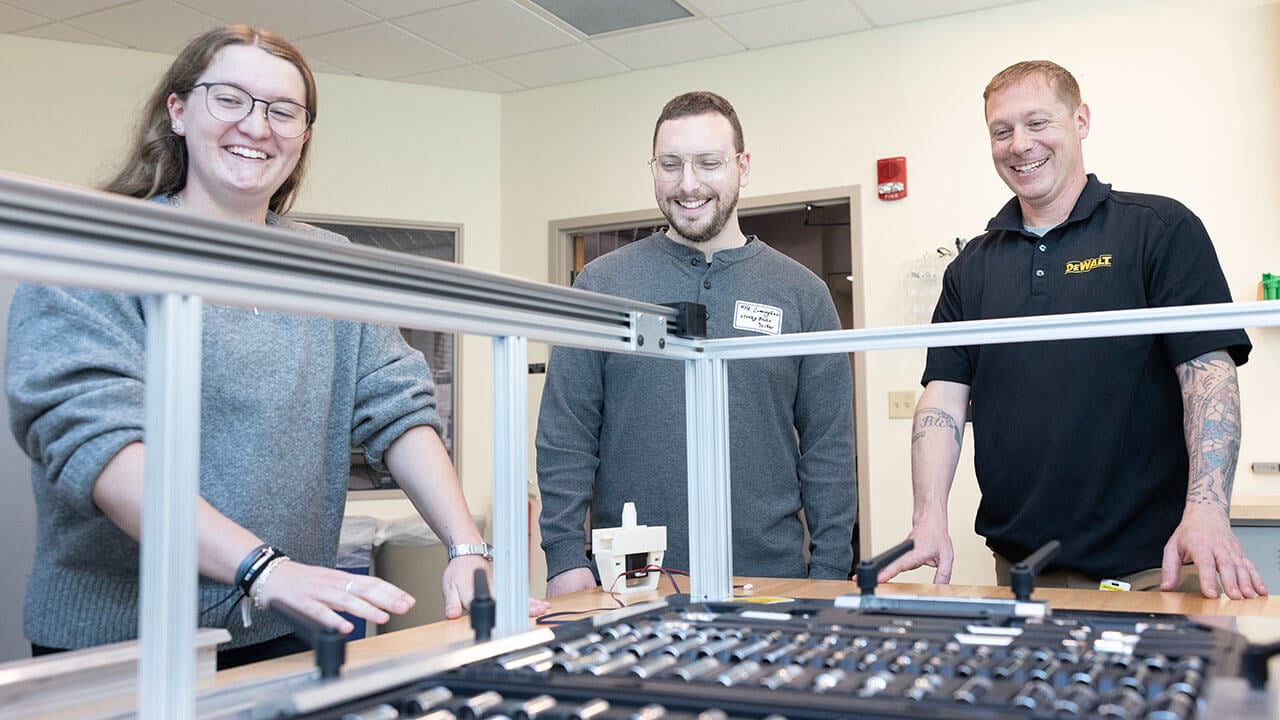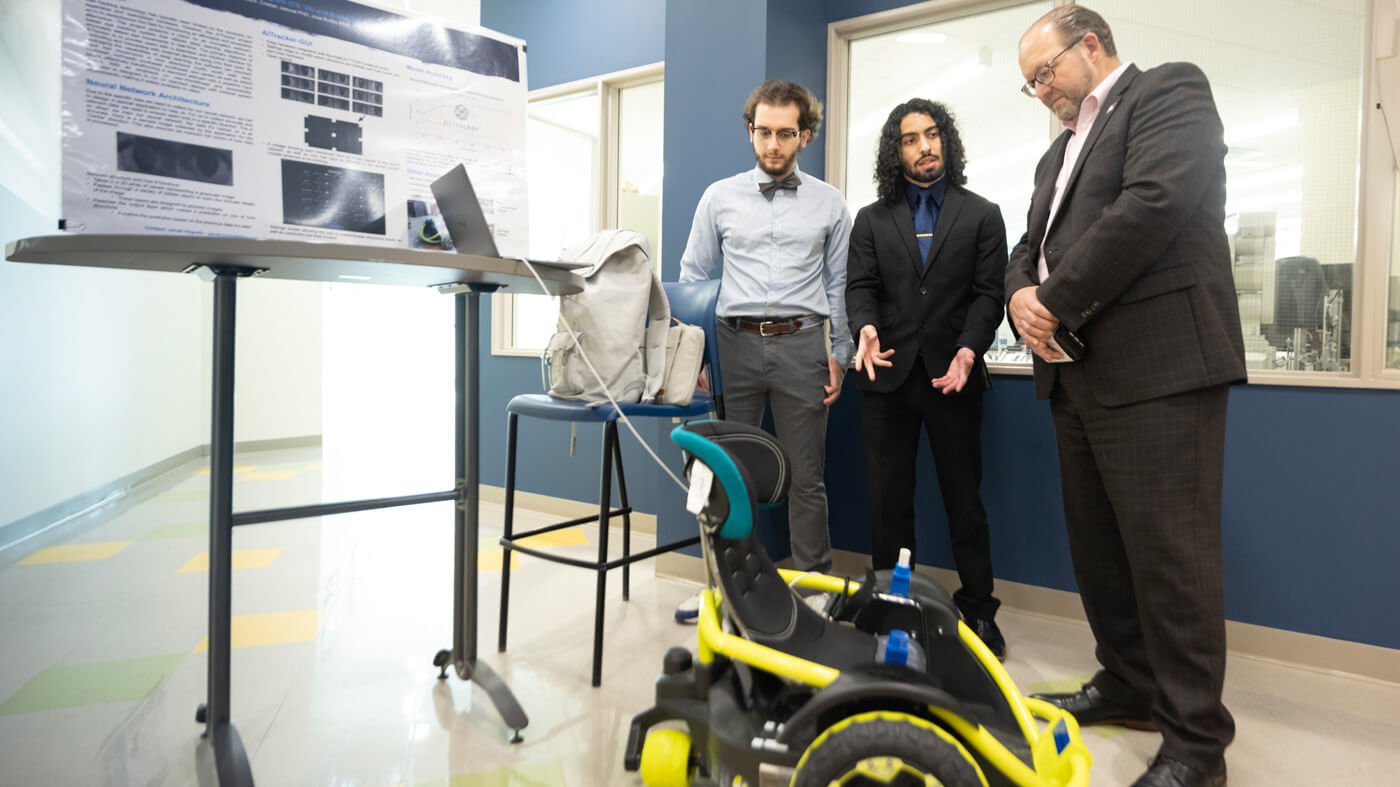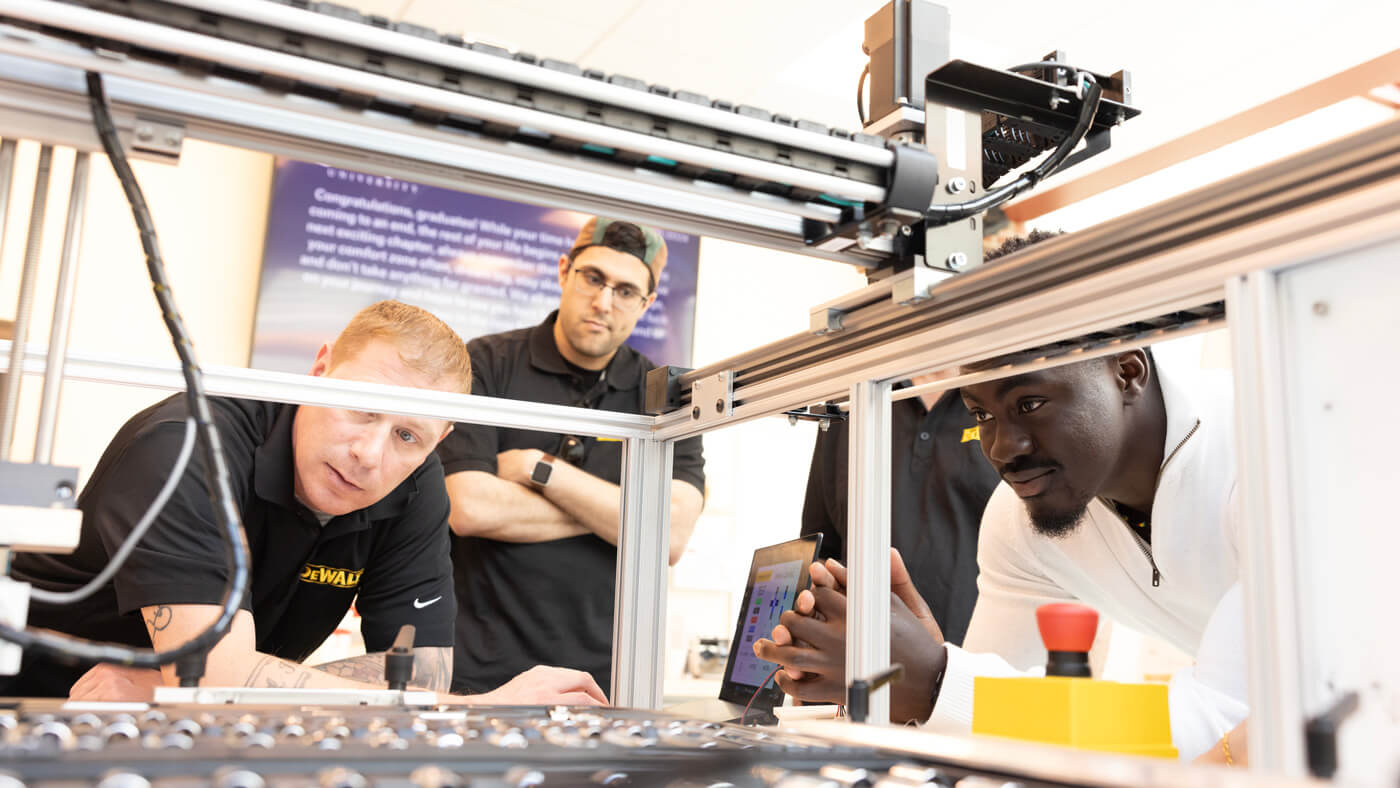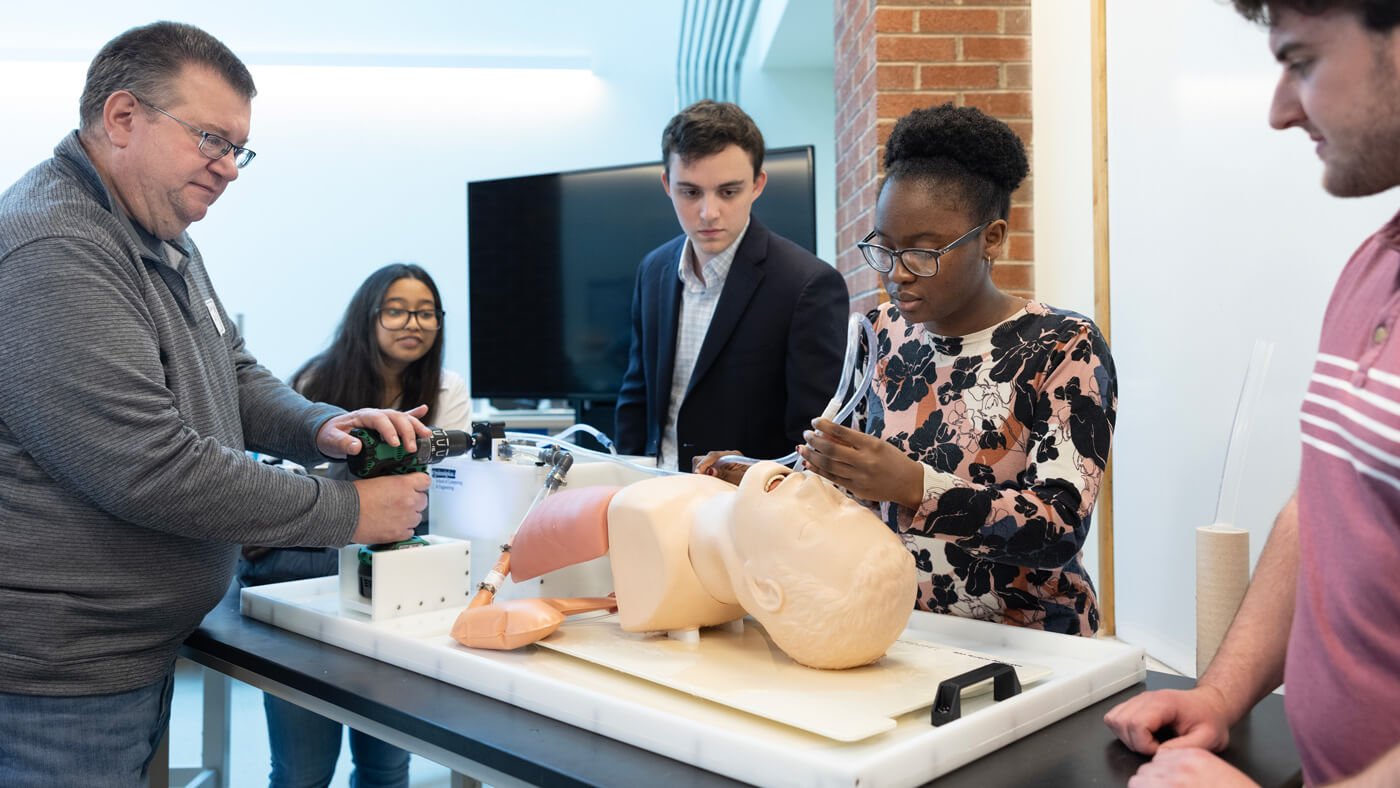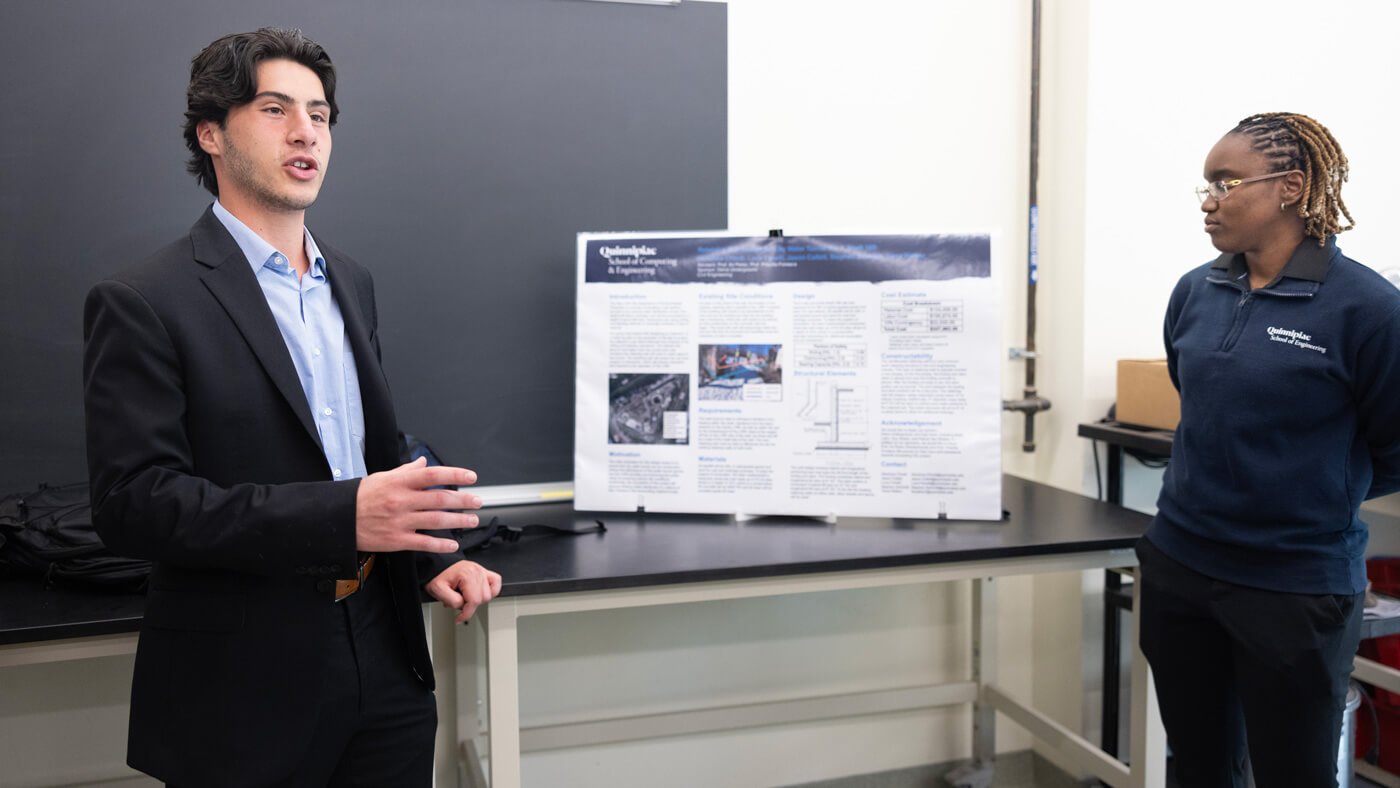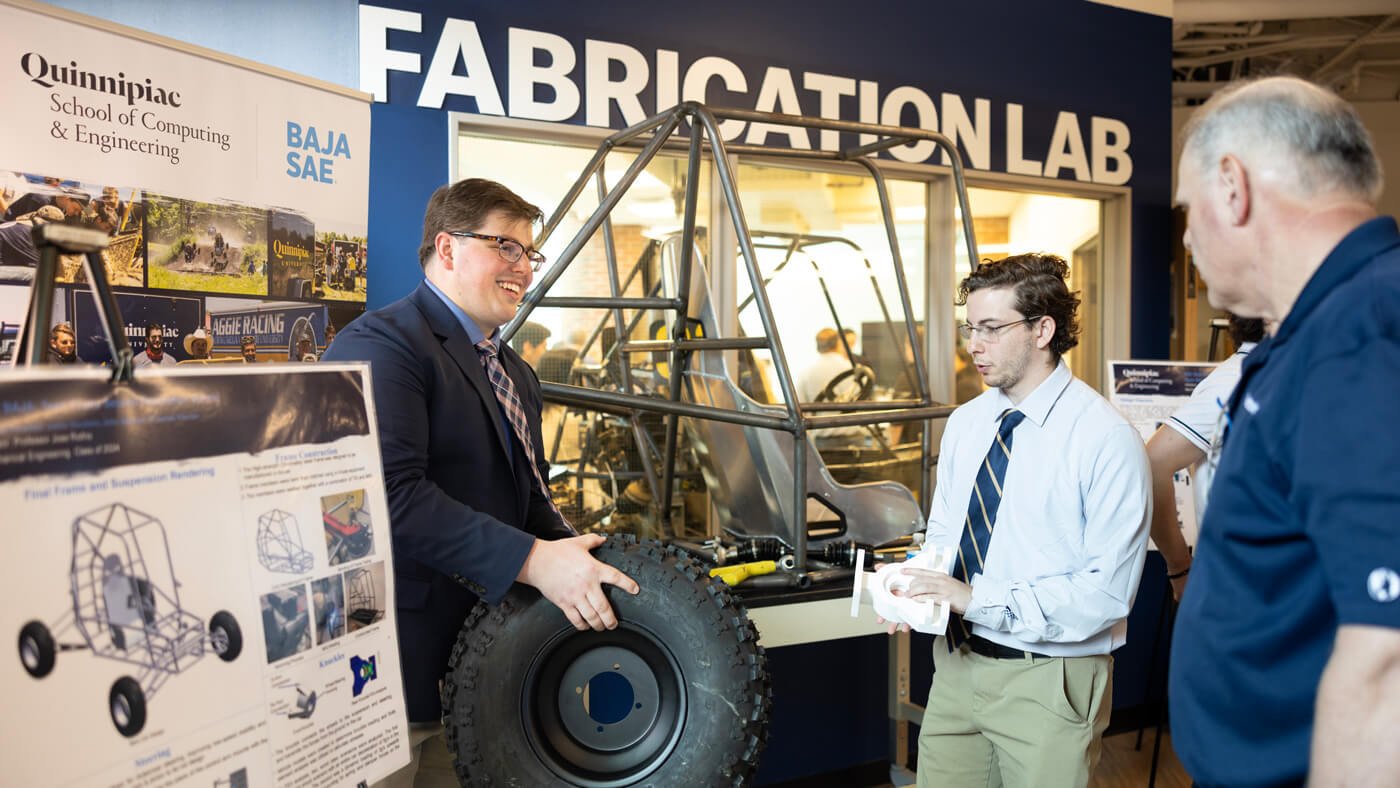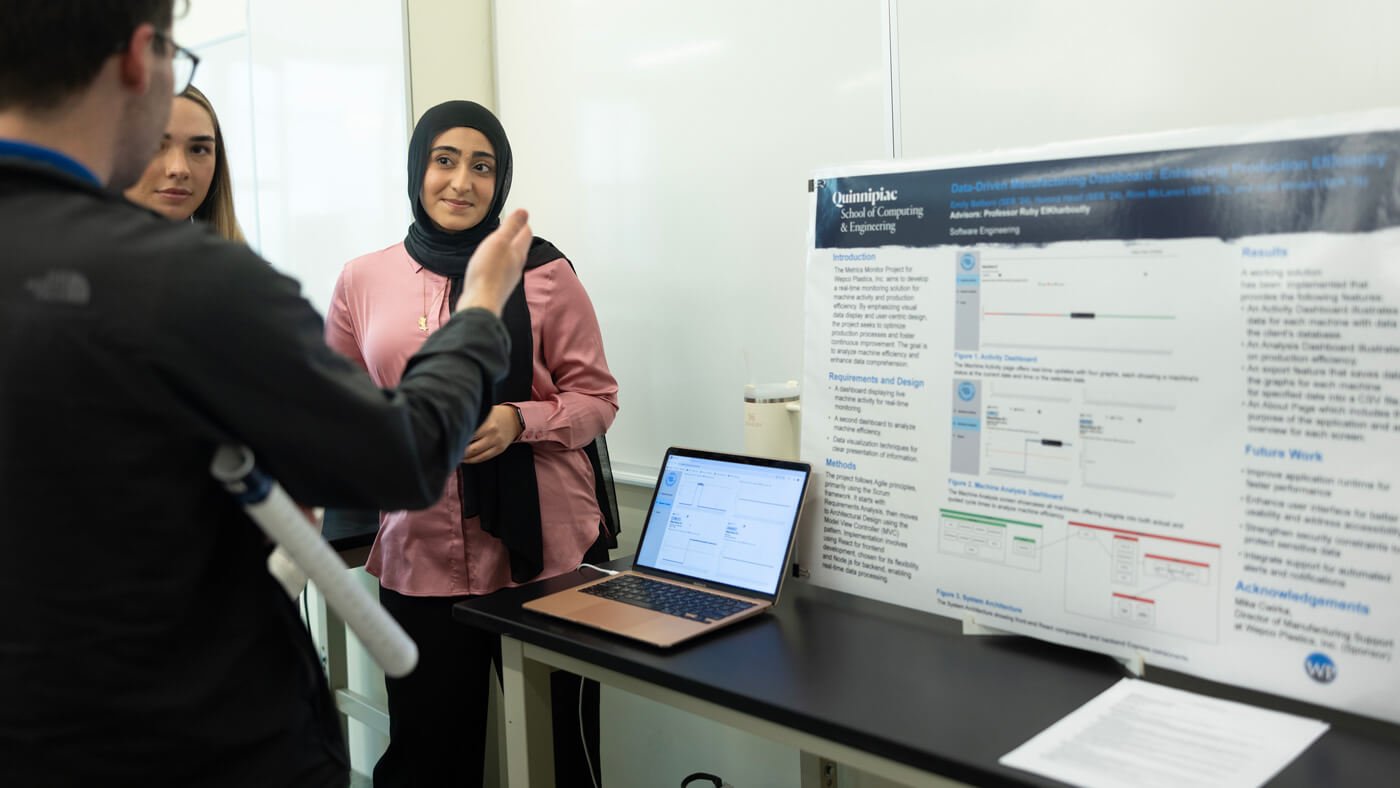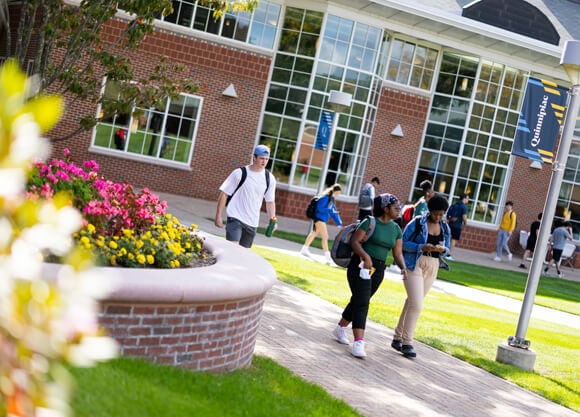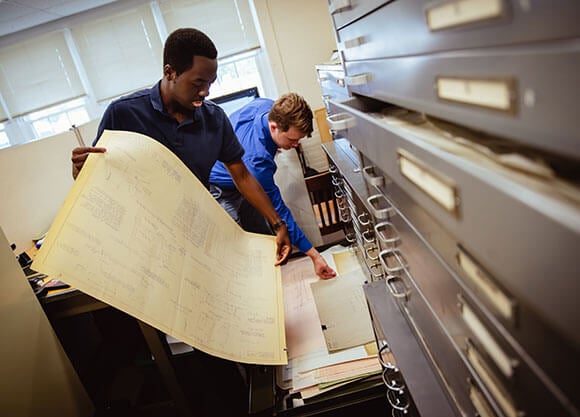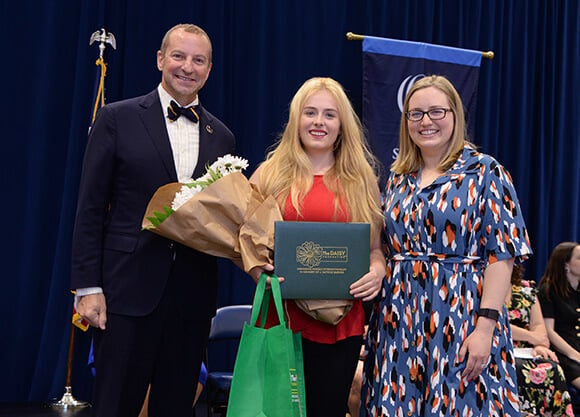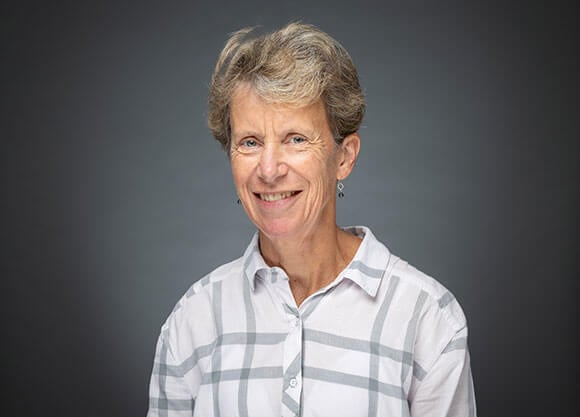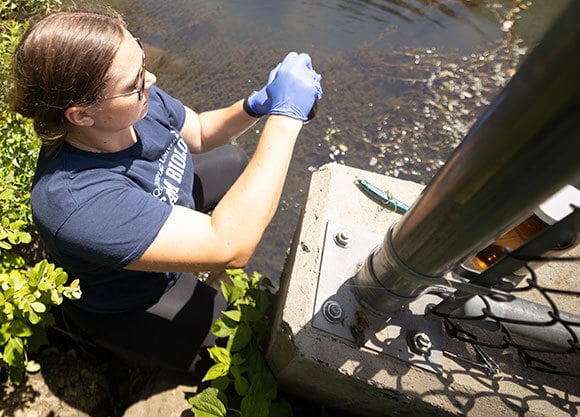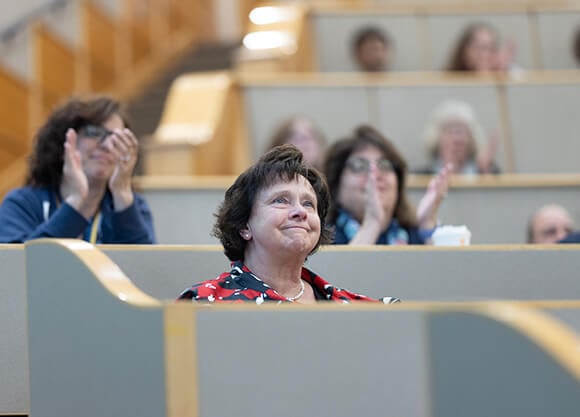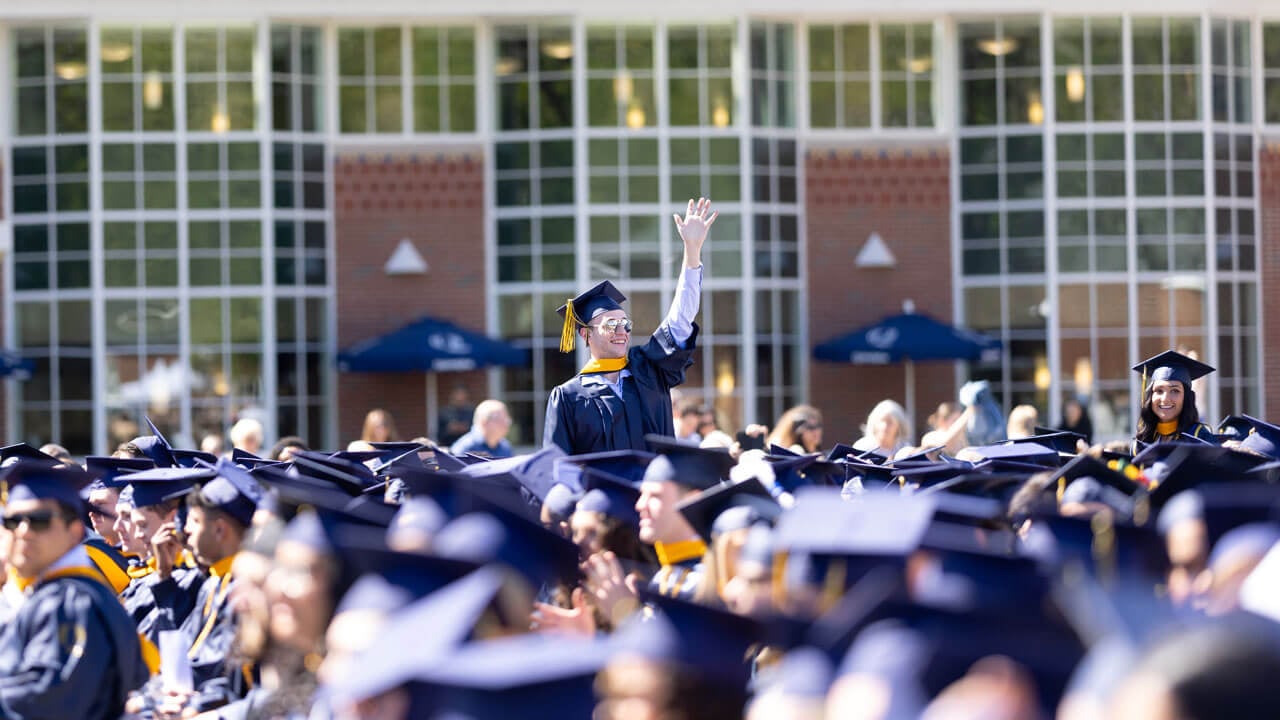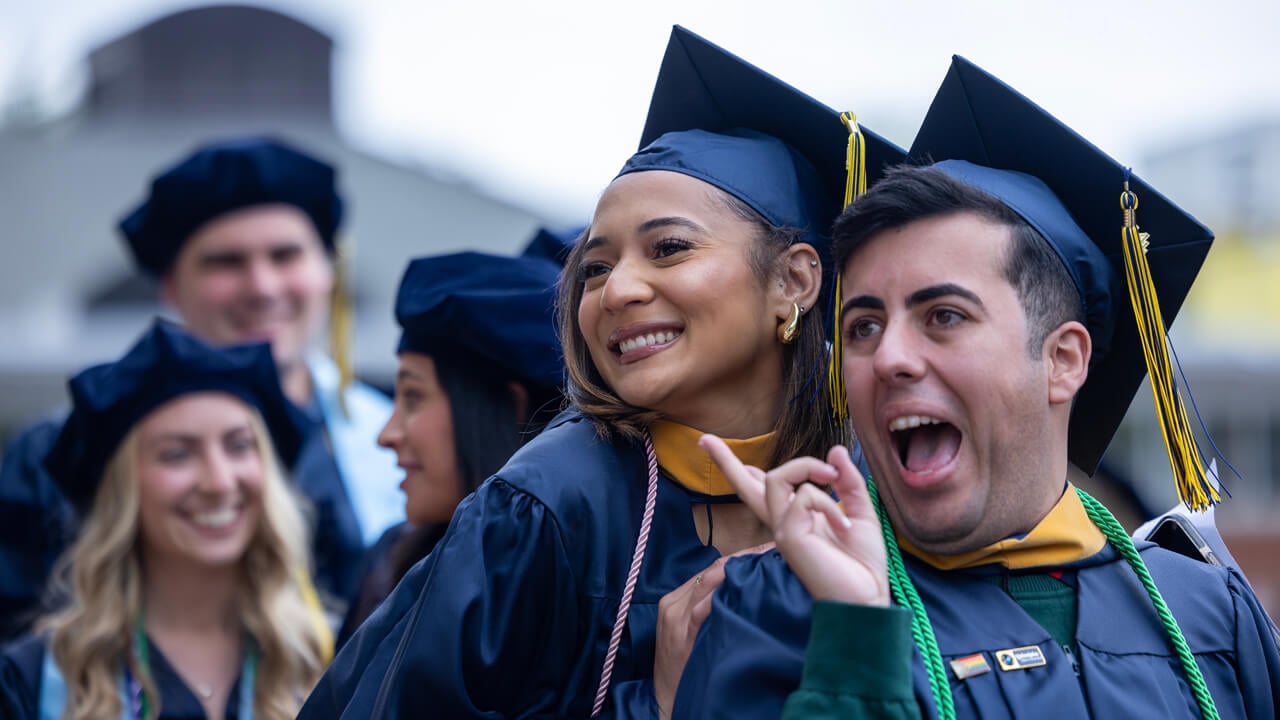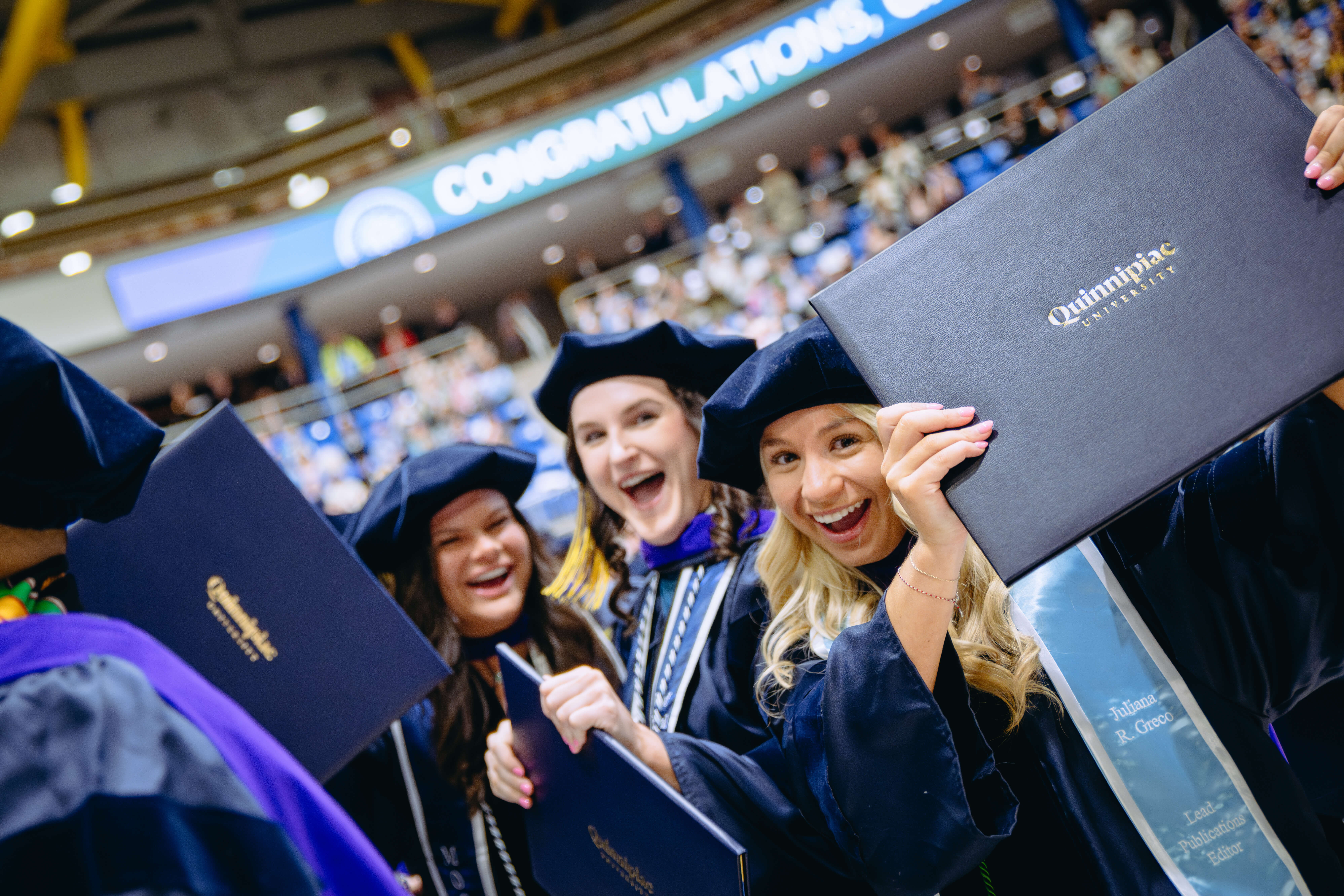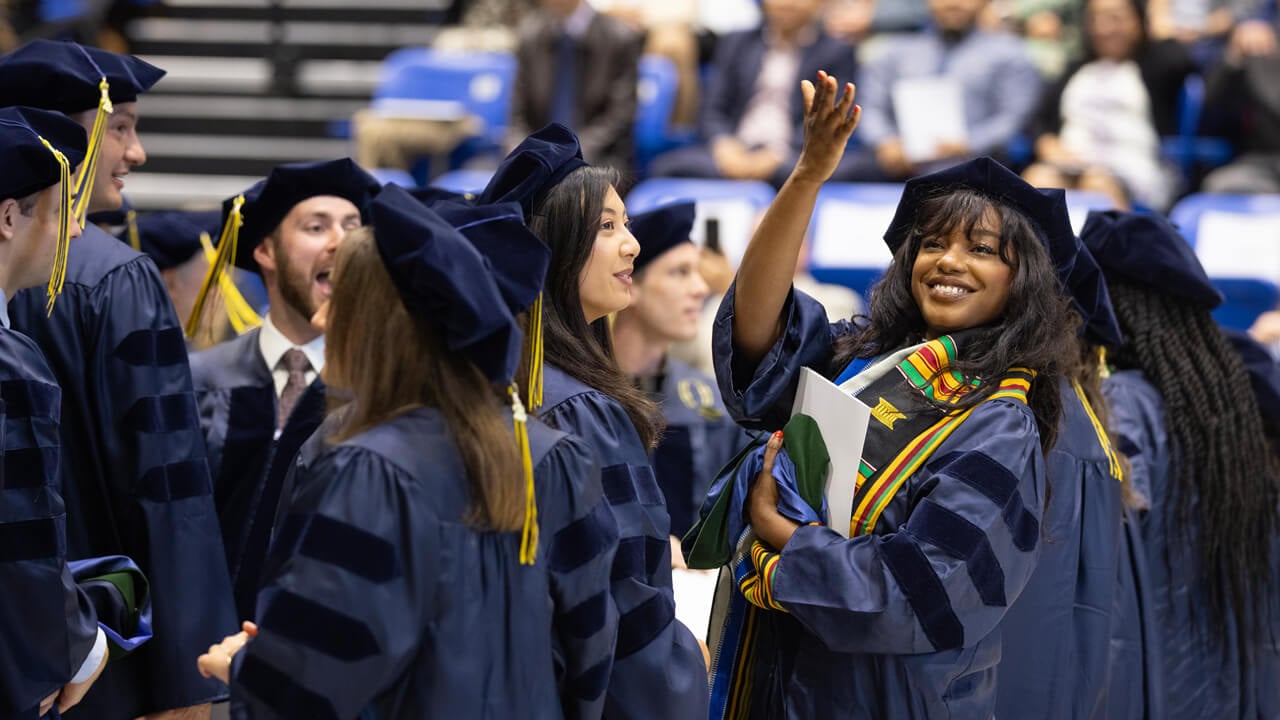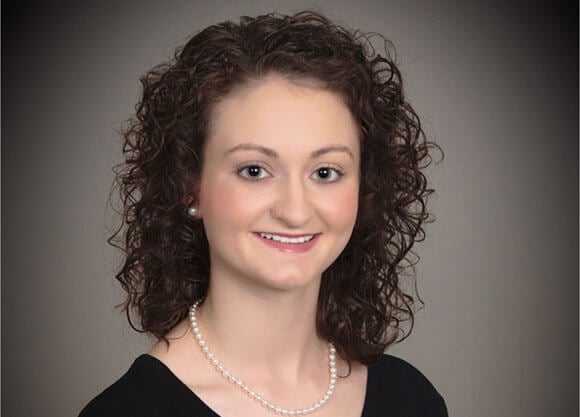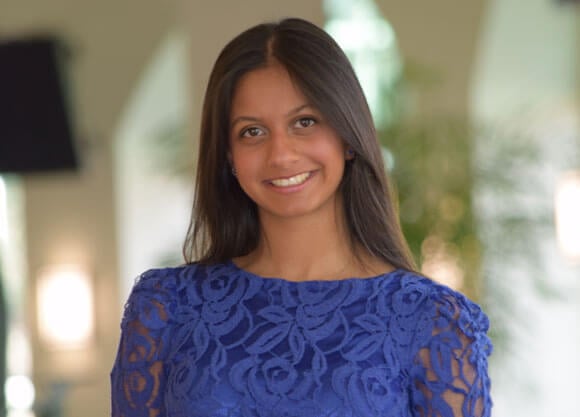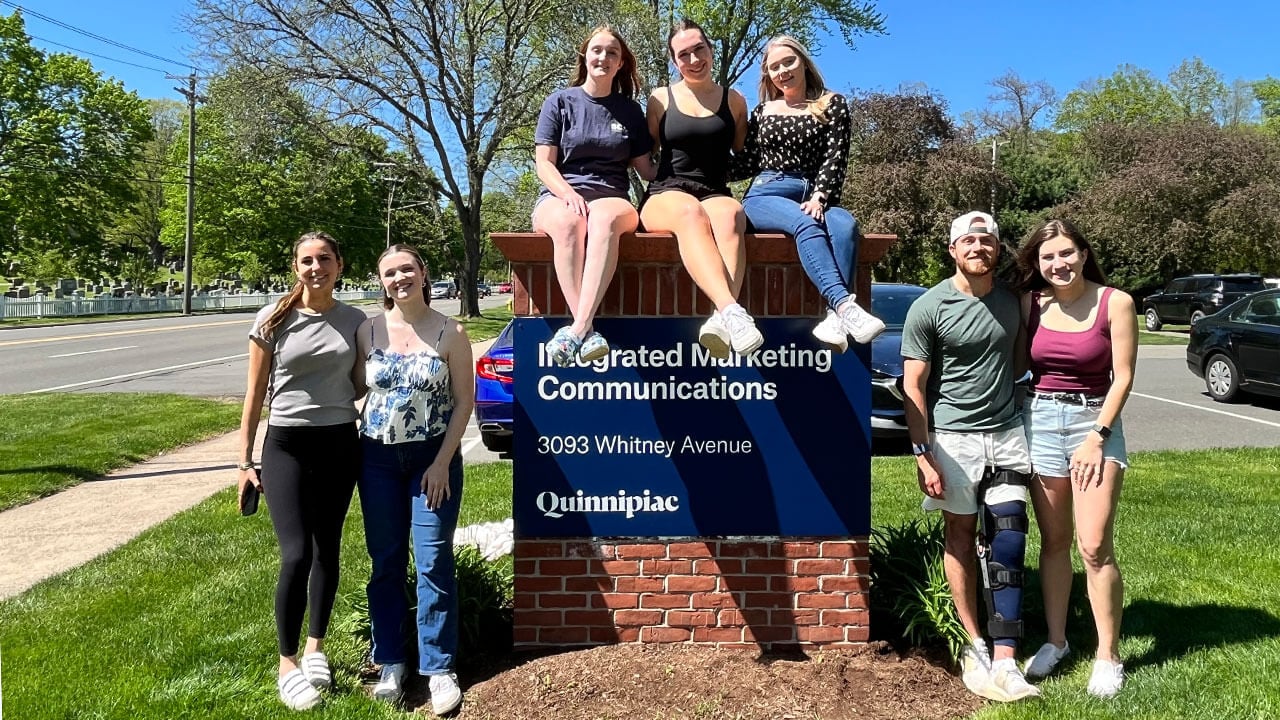
The special occasion on May 8 marked the culmination of a year’s work on a wide variety of more than 30 student projects. Seniors representing the disciplines of civil engineering, computer science, industrial engineering, mechanical engineering, and software engineering presented and demonstrated their findings to faculty, staff, representatives of project sponsor companies, visiting professionals, employers, and parents.
Taskin Kocak, dean of the School of Computing and Engineering, encouraged the day’s guests to discover more about each of the innovative projects and talented participants.
“We encourage you to immerse yourself in the presentations and engage in discussions with the various student teams. Your presence on this special day means a great deal to us as we come together to celebrate the accomplishments of our students, staff, and faculty,” said Kocak.
John Bau, director of career development at the School of Computing and Engineering, said Projects Day is an exceptional opportunity for project partners, sponsors, and other employers interested in working with Quinnipiac students to encounter their exceptional work first-hand.
“Employers visiting today are either employers involved in the student design process, ones who are considering doing it in the future, or quite frankly just enjoy meeting our students,” said Bau.
Ken Witmyer, an aviation software engineering manager with Garmin, was enjoying attending Projects Day as part of a new relationship the international company is forming with Quinnipiac.
“We have a very small office here in Connecticut, and I’m trying to reach out to local universities so we can start tapping some of the talent,” said Witmyer. “As it happened, we had posted internship opportunities and had a favorable response, and we brought on two Quinnipiac interns who will be joining us two weeks from now. And today, I’ll be checking out the senior projects. It’s been great relationship so far.”
Several of the presentations were visited by external industry partners which had sponsored student projects geared to develop solutions to real-world problems.
Wepco Plastics sponsored industrial engineering majors Joe Fragoso ‘24, Bill Regan ‘24, Emre Topcu ‘24, and Kevin Tuohy ’24 to develop a production scheduling project. Through Python programming, the team aimed for an optimal solution across multiple machines to offer Webco Plastics a standardized process to streamline scheduling.
Civil engineering majors Gianluca Chiodi ‘24, Jason Collett ’24, Luca Fanelli ’24, Stephen Schmidt ’24, and Tiana Walker, ’24 spent the past year digging into a problem facing their project sponsor client, Delve Underground.
On May 8, they presented their findings to their client as well as many interested visiting professionals. The group learned on May 8 that Delve Underground plans to implement the project’s successful retaining wall design, which will protect the adjacent Long Island Railroad to ensure it can remain operational during the drilling and blasting of the shaft for a city water tunnel in Queens, New York.
Mechanical engineering majors Vicky Adigolo ’24, Owen Coates ’24, Ariel Khemraj ’24, and Andrew O’Keefe ’24, were sponsored by Hartford HealthCare Center for Education, Simulation & Innovation (CESI) to design and implement an ability for a patient simulator manikin to eject stomach contents through the mouth (vomit) as an instructional tool in the suction-assisted laryngoscopy and airway decontamination (SALAD) technique.
“We attended Hartford HealthCare’s symposium where they actually had incoming EMT’s, EMS’s, nurses, nurse practitioners and other health care providers to practice using this device,” said Khemraj. “Some people walked in not knowing how to use the SALAD technique and walked away feeling a lot more confident in using that technique in the real world.”
Part of the design incorporated a mounted variable speed drill used to simulate different rates of material flow. The team also met the challenge of designing a lightweight, liquid proof, portable simulator at a lower cost than current models.
“In thinking about the numbers, we were thinking about three main things: pump flow rates and how fast the liquid will flow through the manikin; the cost; and also the weight of the manikin,” said Coates.
Hartford HealthCare CESI also sponsored Computer Science BS majors Jonathan Mason ‘24, Matthew Merritt ’24 and Michael Merritt ’24, for a project to develop the Quinnipiac Virtual Medical Simulation. The team offered a solution for creating highly customizable virtual reality simulations that mirror real procedures.
The application supports loading models and assets, building and creating scenarios, practicing inside simulated scenarios, and reviewing results through replays and performance statistics.
Sponsoring organization Stanley Black & Decker put mechanical engineering team members Shivani Bhagania ’24, Dylan Donnery ’24, Anna Hartzheim ’24, and Charles Okang ’24, to the test.
The team designed and built a test rig to measure the insertion and removal force of tools which are stored in plastic “blow mold” cases which are molded to hold the tools in place.
“Our project is creating a test rig that measures the removal and insertion forces of sockets in the blow mold cases,” Hartzhiem said.
Quinnipiac alumnus Jason Lapan ’19, is now a mechanical engineer for Stanley Black & Decker test lab. He assisted the student team as a mentor over the past year as they developed and refined the rig.
“This is one of the biggest projects Quinnipiac’s taken on, and they did a great job,” said Lapan. “This project gave the students experience with automation, working on a complex project, being part of a team, and knowing their roles. They basically did one of our projects for us. This project will be implemented.”
Students obtaining a BA in Computer Science brought their senior capstone experiences to Project Day. Each presented a thesis exploring Computer Science and another discipline they’ve studied as another major or as a minor. From this liberal arts perspective, the resulting projects offered a deeper dive into issues, ideas, and challenges pertaining to computer science.
“Computer science is as much a thought process as a discipline as it is the nuts and bolts of learning something. So anytime students can explore applying that process to other passions that they have, they’re making themselves stronger candidates for jobs or anything else,” said Jonathan Blake, director of Software Engineering and BA in Computer Science.
Computer science BA major Gregory Jean-Baptiste put his fine arts minor to work to develop his thesis, “The Grammar of Art.” His thesis explores the notion of an objective measure of aesthetics which would be the first step in getting a computer to generate art that people will appreciate.
“This project explores artificial intelligence and its ability to generate aesthetics. It involves the use of AI-generated images as a baseline for determining if artificial intelligence is able to generate an aesthetic and delves into a serious discussion of whether artificial intelligence can generate aesthetics in 3-dimensional sculptures,” Jean-Baptiste said.
Elizabeth Delea, ’24, MS ’25 (Cybersecurity), blended her Computer Science BA with her minor in psychology to develop her thesis on breaking social media addiction, “The Importance of Integrating User Psychology into Design Practices.”
“In my generation, we’re all addicted to social media; but this causes a lot of adverse effects such as depression, anxiety, and trouble with relationships, friendships and time management,” said Delea.
Delea said there should be an intersection that allows companies to still make a profit from returning users, but not to the point of addiction to technology. Her thesis explores the crucial intersection between user psychology and design practices, emphasizing the need to prioritize both user engagement and well-being.
Among several projects initiated inside Quinnipiac were those involving the QU Baja vehicle. Mechanical engineering majors Justin Goodwin ’24, James Kiernan ‘24, Forrest Paradise ’24, and John Stewart ’24, designed a frame, front/rear suspension and steering system for Quinnipiac’s next-generation Baja vehicle. Among many remarkable accomplishments, the new frame is stronger, yet weighs 50% less than the original frame.
“It’s stronger and lighter and will perform better,” said Paradise.
Stewart said the process involved different math calculations, such as applying finite element analysis, to ensure the new frame design was strong enough.
“We needed to figure out if our car would survive in extreme failure cases; and everything passed with flying colors,” said Stewart. “We overengineered this car to a large degree so that we could maintain the durability that we had in our first design but gain the improvements in weight and speed and other survivability.”
Their work will interface with the results of another project team’s work to develop the new Baja drivetrain and brake design, produced by mechanical engineering majors Keith Bauer ‘24, Marcus Fabiunke ’24, Jake Fitzpatrick ’24, and Rob Jata ’24.
Quinnipiac’s Program Director for Mechanical Engineering, Lynn Byers, said Projects Day is a great day to celebrate all of the hard work students have put in over the last two semesters, but there is more to celebrate, as well.
“Part of our school mission talks about the transformation of our students, and this is a really great visual representation of that transformation. They came in as first-year students during orientation, and now they’re going to be working professionals. To be part of that transformation is what makes this so awesome,” Byers said.
In this Article
Stay in the Loop
Quinnipiac Today is your source for what's happening throughout #BobcatNation. Sign up for our weekly email newsletter to be among the first to know about news, events and members of our Bobcat family who are making a positive difference in our world.
Sign Up Now